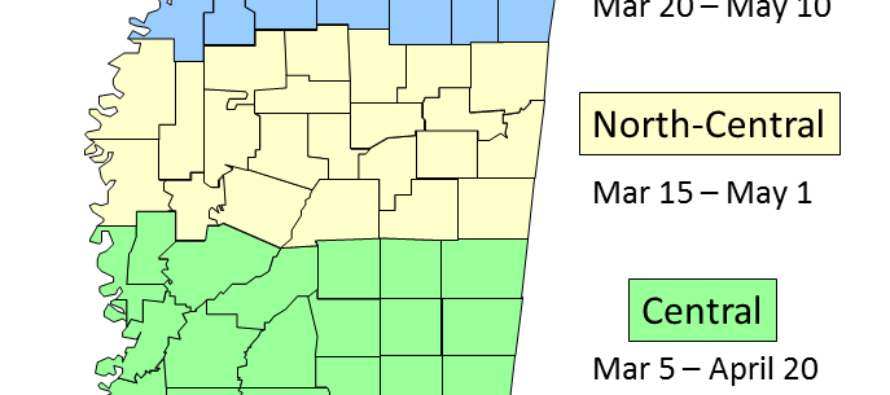What is the Cut-Off Date for Planting Corn?

 Much like last year, frequent rains have delayed corn planting progress thus far during the spring of 2014. This brings up questions regarding the appropriate “cut-off” date for planting corn, or if this term is really relevant. Fortunately, we have a strong research database at Mississippi State University as well as the University of Arkansas to answer these questions. The primary objective of this research was to evaluate the yield response of modern corn hybrids, possessing Bt technology for corn borer protection, to well later than normal planting dates. Thus, we can utilize this information to make better cropping decisions, particularly when rainfall delays planting or we are faced with replanting decisions. Irrigated field studies were conducted in 2009, 2010 and 2011 at the MSU Delta Research and Extension Center at Stoneville and the RR Foil Research Center at Mississippi State University using the furrow irrigation method. Corn produced optimal grain yields until about May 1, when productivity began to decline. Corn yield loss was quite moderate through May, until declining quickly in June. The magnitude of irrigated corn yield reduction associated with planting beyond the optimum time frame was 1.3 bu. per day or 0.76% per day for plantings during May and increased to 2.1 bu. per day or 1.59% per day for June plantings. The numbers on the X-axis in the figures below represent the Julian date of the year (75=March 15, 165=June 13). The trendline shows the response of five hybrids (each represented by a different color) planted at 2 to 2 ½ week intervals over the duration of the study.
Much like last year, frequent rains have delayed corn planting progress thus far during the spring of 2014. This brings up questions regarding the appropriate “cut-off” date for planting corn, or if this term is really relevant. Fortunately, we have a strong research database at Mississippi State University as well as the University of Arkansas to answer these questions. The primary objective of this research was to evaluate the yield response of modern corn hybrids, possessing Bt technology for corn borer protection, to well later than normal planting dates. Thus, we can utilize this information to make better cropping decisions, particularly when rainfall delays planting or we are faced with replanting decisions. Irrigated field studies were conducted in 2009, 2010 and 2011 at the MSU Delta Research and Extension Center at Stoneville and the RR Foil Research Center at Mississippi State University using the furrow irrigation method. Corn produced optimal grain yields until about May 1, when productivity began to decline. Corn yield loss was quite moderate through May, until declining quickly in June. The magnitude of irrigated corn yield reduction associated with planting beyond the optimum time frame was 1.3 bu. per day or 0.76% per day for plantings during May and increased to 2.1 bu. per day or 1.59% per day for June plantings. The numbers on the X-axis in the figures below represent the Julian date of the year (75=March 15, 165=June 13). The trendline shows the response of five hybrids (each represented by a different color) planted at 2 to 2 ½ week intervals over the duration of the study.
Dryland studies were conducted at the RR Foil Research Center at Mississippi State University in 2010, 2011 and 2012. Corn planted at later dates in dryland culture suffered more consistent yield loss than irrigated corn. However, pollination failure or catastrophic yield loss never occurred, despite corn being exposed to two of the most severe drought seasons in Mississippi history during 2010 and 2011. The magnitude of dryland corn yield reduction was 1.3 bu. per day or 0.83% per day for plantings after Mid-April. Although substantial, this productivity loss was relatively moderate and not substantially different from Corn Belt studies. The numbers on the X-axis in the figure below represent the Julian date of the year (95=April 4, 155=June 3). The trendline shows the response of five hybrids (each represented by a different color) planted at 2 to 2 ½ week intervals over the duration of the study.
These results indicate several key findings.
- Foremost, yield reduction associated with late-planted irrigated corn initially gradually declines and escalates with time. However, irrigated corn productivity does not abruptly nose-dive during May. Thus, there is little justification to “cut-off”or completely abandon corn planting intentions, if planting is slightly delayed past optimum dates.
- Also, these results show irrigated corn may produce optimum yields about 10 days later than our old guidelines, which differ depending upon latitude regions of our state.
- Yield reduction associated with late corn plantings grown in dryland culture is likely to steadily decline.
- Based upon our research, this figure represents more appropriate corn planting guidelines for Mississippi.
Therefore, I believe there is little reason yet to surrender hope, as planting date is only one of numerous factors which ultimately influence corn yield potential, particularly if you have irrigation capability. After all, we had some corn planted in late May last year that produced excellent yields.
If rains do continue to delay planting, there are a few management adjustments we suggest. It is much more important to utilize Bt technology for insect protection when planting late, so try to use those traits with lower refuge requirement (20%) when doing so. I also suggest reducing your seeding rate for late plantings, because late corn generally develops more height and leaf area. This will also help alleviate the effect of drought stress, particularly for dryland production.







Thanks Erick! I have a few customers that have made commitments for corn delivery in 2014 but don’t have enough corn planted as of today. This will at least give us an opportunity to discuss later planting dates.